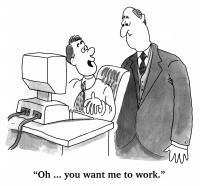What Is Fauxductivity?
Fauxductivity, or “faking productivity”, is an increasingly prevalent workplace practice that involves making it appear you are working when in reality you aren’t being productive. Fauxductivity may appear as laziness among workers, but in reality it’s an indicator of broken systems.
This practice may take various forms, such as mouse jiggling and false timesheet entries being two such tactics. Another example is leaving your laptop open to check social media and email, while on the phone. Even managers fall prey to this issue, with 37% admitting to fauxductivity, while 32% of non-managerial employees admitted the same behavior.
At first glance, these behaviors may appear harmless. However, their harmful impact becomes clear when people spend too much energy maintaining appearances instead of doing meaningful work. Remote and hybrid work environments exacerbate this issue, as leaders find it more challenging to oversee employee behavior. Additionally, employees often feel that maintaining certain levels of productivity in order to advance in their careers can create burnout, as well as an unhealthy culture of performance pressure.

Why Do People Fake Productivity?
Workplaces that foster fauxductivity reduce productivity and cause employees to conceal their true levels of effort, which can be damaging to a company. Don’t mistake fauxductivity for laziness or incompetence. However, it is indicative of toxic cultures with misplaced priorities regarding what work should be worth in terms of value creation.
Employees who fake productivity may do so to avoid the consequences of admitting their disengagement and poor performance. This can be a response to unsustainable workloads, micromanagement, or an increase in surveillance, which leads to an obsession with tracking worker activity.
Managers may more often fake productivity than nonmanager counterparts due to motivations such as wanting work life balance, or appeasing upper management, as possible motivations for falsifying productivity levels.
Leaders can help break this charade by shifting focus away from activity to outcomes. This can be accomplished by revising work definition to include elements such as team collaboration, reinforcing that output over clocking hours is more essential. Another way is by creating an atmosphere in which employees feel safe enough to express their frustration or require breaks without feeling shamed. Doing so may produce better results than staying silent and pretending the job will get done properly.
How Can Leaders Prevent Fauxductivity?
In an environment characterized by hustle culture, employees may often fake productivity to appear busy and valuable to their managers or coworkers. This behavior isn’t due to laziness, but it reflects broken systems that prioritize appearances over meaningful work. To address this problem effectively, change must occur within workplace culture so employees focus on meaningful results instead of appearing to be busy.
Leaders can effectively address fauxductivity by setting clear expectations, streamlining communication, and setting realistic deadlines. Leaders can foster a culture of ownership among team members by encouraging them to accept full responsibility for their performance and self-accountability. In addition, leaders can foster more focused and productive workplace environments by emphasizing deep work concepts.
Fauxductivity can be an easily avoidable and damaging trap that leads to employee burnout, decreased productivity, and strain between team members. Left unaddressed, it may even result in teams losing their competitive edge. Yet all this can be easily prevented.

What Can Leaders Do About Fauxductivity?
Fauxductivity doesn’t result from employee laziness. Rather, it stems from a toxic workplace culture that rewards appearances over meaningful achievements. Leaders can take several measures to stop such behaviors before they take hold and damage productivity and morale.
Effective ways to combat fauxductivity include providing employees with all of the resources and time necessary for them to complete their tasks on schedule, which means eliminating bureaucracy and giving managers authority over establishing clear expectations for all team members.
As part of your second strategy for increasing employee motivation and satisfaction in their jobs, help employees find meaning in what they do by showing them real artists like Shepard Fairey, Yayoi Kusama, Kehinde Wiley and Marina Abramovic who have managed to balance creativity with smart business practices.
Finally, leaders should focus on improving workplace culture. This may involve creating more flexible work schedules, giving employees tools for collaboration remotely, and encouraging honest communication between staff members. If employees must falsify themselves in order to meet management expectations, they may eventually abandon the company unless root causes are addressed. By doing so, leaders can create environments which foster genuine engagement and meaning.
